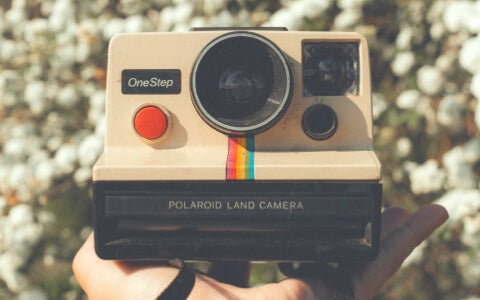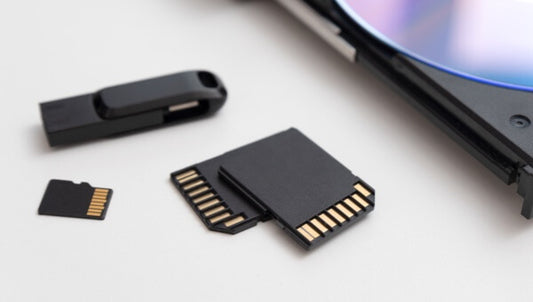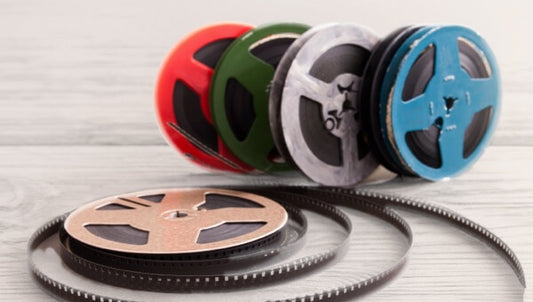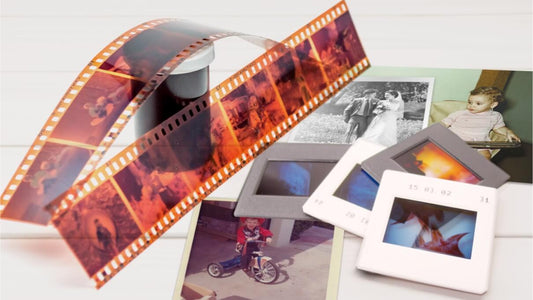Today, nearly everyone carries a digital camera in their pocket, capturing and sharing memories in an instant, but this everyday technology had humble beginnings. The concept of the digital camera was first imagined in the 1960s, with the first working prototype built in 1975 by a Kodak engineer. From that moment on, photography began a rapid evolution from film to digital. In this article, Capture’s archival experts explore the history of the first digital camera, how it was developed, key breakthroughs in the 80s and 90s, and what the future holds for digital imaging in a world shaped by smartphones and AI.
Jump to Section:
- The Concept of Digital Cameras
- Who invented the first digital camera?
- When did companies start developing digital camera technology?
- How Digital Cameras Evolved into Smartphones
- Digital Camera Milestones: 1975 to 2025
- Future of Digital Cameras
- Glossary of Key Terms
- From Prototype to Pocket: A Lasting Legacy
The Concept of Digital Cameras
The concept of digital photography began long before the technology was available to capture digital images. In the early 1960s, a man named Eugene F. Lally who worked in the NASA Jet Propulsion Laboratory had the idea to capture digital images using a mosaic photosensor (an early vision of digital imaging).
His idea was to develop new technology that could take pictures of the planets and stars while traveling through space. This would provide relevant information about the astronauts’ locations. While this concept would take over a decade to contribute to any real prototypes, Lally did figure out how to remove red eye in analog photos. At the time, photography was still dominated by old-fashioned cameras that relied on film, chemistry, and mechanical parts.
Then, in the early 1970s, Texas Instruments employee Willis Adcock patented the idea for a filmless camera. Around the same time in 1972, the Landsat 1 satellite would start using the multispectral scanner (MSS) to take digital images of the Earth. For 6 years, this satellite would transmit over 300,000 digital photographs of the planet and orbit 14 times every day.
Over the next few years, other attempts at an all-digital camera were proposed, but ultimately failed. This included the Cromemco Cyclops which was introduced in 1975 and published in Popular Electronics magazine. That same year came what is generally known as the first digital camera.

The concept of digital photography was first imagined in the 1960s.
Who invented the first digital camera?
The world’s first digital camera was developed in 1975 by Eastman Kodak engineer Steven Sasson in Rochester, New York. The bulky prototype weighed nearly 4 kilograms and looked more like a toaster than a modern camera. While it could only capture black-and-white images onto a digital cassette tape, the invention laid the groundwork for today’s digital photography.
How was the first digital camera built?
Sasson built the prototype using a movie camera lens, Motorola parts, 16 AA batteries, and charge-coupled device (CCD) sensors - a new imaging technology originally developed by Fairchild Semiconductor, RCA, and Texas Instruments. These components enabled the camera to convert light into digital data for the first time.
While today’s camera phones offer 12-megapixels, or 12 million pixels in a single digital image, the original Kodak digital camera offered .01 megapixels.
What was the first digital photo?
After a year of working on the cameras, Sasson took the first photo in December of 1975 of Kodak lab technician, Joy Marshall. While it only took around 50 milliseconds to capture the image, saving it to the cassette tape took 23 seconds.
How did the first digital camera work?
To use the camera, the photographer would flip a switch to turn it on and then flip it a second time to take the photo. The CCD would capture the image and run it through an analog to digital converter to be stored temporarily on a computer chip. Then, the image was transferred to a cassette.
Since screens didn’t exist yet for previewing photos, Sasson and his team created a custom NTSC playback device to display the image on a television.
Why didn’t Kodak release the first digital camera?
Sasson received a patent for the digital camera in 1978, but Kodak chose not to commercialize it. Despite the breakthrough, the company feared that digital cameras would threaten their core film business. That decision delayed the rise of digital photography and would later be seen as one of Kodak’s biggest missed opportunities and a turning point in the evolution of the camera.

The first digital camera was invented by Steven Sasson at Kodak in 1975.
When did companies start developing digital camera technology?
By the early 1980s, tech giants like Sony, Fujifilm, and Canon began exploring digital imaging innovations. These included LCD viewfinders, solid-state sensors, and experimental storage methods that paved the way for fully digital cameras - many of which defined the era’s most notable 1980s cameras.
What was the Sony Mavica?
In 1981, Sony introduced the Mavica (Magnetic Video Camera) - a prototype SLR-style camera that stored analog still images on 2-inch floppy disks called Mavipaks. Though not fully digital, it marked an important bridge between film and digital photography. Each disk could store up to 50 color images with ISO 200 sensitivity and a 1/60 shutter speed.
The Mavica wasn’t technically digital, but it was the first electronic SLR camera publicly demonstrated.
What was the first electronic SLR camera sold in the U.S.?
In 1986, Canon introduced the RC-701, the first electronic SLR (Single-Lens Reflex) camera sold in the United States. It featured an SLR optical viewfinder, a CCD sensor, and interchangeable lenses, making it a favorite among journalists covering the 1984 Olympics before its wider release. While it still recorded analog still video rather than digital files, it represented a major leap toward DSLR-style functionality.
What was the first digital camera for consumers?
In 1988, Fujifilm released the FUJIX DS-1P, the first fully digital camera to use a semiconductor memory card for storing digital photos. Shortly after, in 1990, the Dycam Model 1 became the first consumer digital camera sold in the U.S. It could store JPEG and MPEG images and connect directly to a computer for download.
When was the first DSLR camera released?
In 1991, Kodak launched the DCS-100, the first commercially available DSLR camera, built by combining a Nikon F3 body with Kodak’s digital sensor and storage. This professional-grade camera accelerated digital photography in newsrooms and creative industries.
Other major companies soon followed - including Apple, who released the Apple QuickTake 100 in 1994. It was the first consumer color digital camera priced under $1,000, making digital photography more accessible to everyday users in the U.S.
In the years that followed, innovation surged:
- Casio QV-10 introduced the first LCD screen and pivoting lens
- Logitech debuted the first webcam
- Kyocera released the first camera phone
- Nikon launched early mirrorless cameras
- Ricoh RDC-1 brought video recording to digital point-and-shoot models
How did digital cameras evolve into smartphones?
By the 2000s, breakthroughs in CMOS sensors, APS lenses, and battery efficiency made it possible to miniaturize high-quality cameras. These technologies laid the foundation for embedding advanced cameras into smartphones, transforming photography into a daily habit.

Companies like Sony and Canon began advancing digital camera technology in the 1980s.
Impact of the First Digital Camera
While it took over a decade from the first digital camera to commercially available options, the first digital camera had a profound impact on film cameras and the photography industry as a whole. The CCD technology and the idea to store digital images with the first digital camera influenced all future digital camera technologies which influence our daily life and experiences.
Due to their convenience, quality, and ability to instantly view images on an LCD screen, digital cameras have largely replaced film. Instead of being limited by rolls of film or waiting for photos to develop, digital photography offered instant feedback and nearly unlimited storage. Unlike old Polaroid cameras, which offered instant prints, digital cameras let users review, delete, or retake photos instantly—without using film or paper.
Some of the key advantages that made digital cameras more practical include:
- Unlimited photos — no need to worry about running out of film
- Instant review — see your shot immediately on a screen
- Easy deletion — remove blurry or unwanted pictures on the spot
- Lower cost over time — no film, no development fees
- More freedom to capture memories — take as many shots as you like without hesitation
Digital cameras also made it possible to compact an entire camera into a smartphone and allowed us all to carry a camera around in our pockets. Additionally, instead of having physical photos that take up space, we can store digital images on the Cloud, memory cards, and hard drives and share them easily across the world over social media and email.
Digital Camera Milestones: 1975 to 2025
Here is a timeline of major milestones in the development of digital cameras from their invention to today:
- 1975 – First digital camera prototype created by Kodak engineer Steven Sasson
- 1981 – Sony introduces the Mavica, a bridge between film and digital
- 1986 – Canon RC-701 becomes first electronic SLR camera sold in the U.S.
- 1988 – Fujifilm releases the FUJIX DS-1P, first to use a memory card
- 1990 – Dycam Model 1 becomes first consumer digital camera in the U.S.
- 1991 – Kodak DCS-100 launches as the first commercial DSLR
- 1994 – Apple releases the QuickTake 100, first color digital camera under $1,000
- 1995–1999 – Casio QV-10 adds LCD screen; Logitech debuts webcam; Kyocera creates first camera phone
- 2000s – CMOS sensors and miniaturization make smartphone cameras possible
- 2010s – Rise of mirrorless cameras and AI-based image processing
- 2020s – Computational photography, cloud syncing, and advanced mobile lenses dominate

Digital camera development progressed rapidly over five decades.
Future of Digital Cameras
While it’s hard to predict what digital cameras will look like decades from now, experts anticipate innovations that go beyond what’s currently possible. The next wave of camera technology may introduce entirely new ways to capture and relive memories—not just visually, but emotionally and sensorily.
Here are some forward-looking possibilities that may define the future of photography:
- Self-powered cameras using advanced solar cells or ambient energy to eliminate the need for recharging altogether
- Scent-based memory recording, like the concept proposed by MIT Media Lab, where a photo could be paired with a preserved scent using microcapsule technology
- Emotion-aware photography, where cameras detect mood through biometric sensors and adjust settings or even curate photo collections accordingly
- Multi-sensory playback experiences, combining visuals, sound, and potentially scent or haptics for immersive memory re-creation
These ideas may sound futuristic, but they point to a broader shift: photography will no longer be just about capturing a scene—it may become a way to preserve experiences more completely.
Thanks to the pioneering work of Steve Sasson and others, the camera continues to evolve—not just as a tool for documentation, but as a powerful medium for connection, creativity, and memory itself.

Future digital cameras may include solar power, scent capture, and AI features.
Glossary of Key Terms
Below are a few key terms mentioned throughout the article to help clarify technical references:
- CCD (Charge-Coupled Device): A sensor used to capture light in early digital cameras, converting it into digital signals.
- NTSC: A video signal standard used in North America and Japan, often referenced in early camera playback systems.
- JPEG: A common image file format used to compress and store digital photographs.
- Mirrorless Camera: A digital camera that uses an electronic viewfinder instead of a mirror system, making it lighter and more compact than DSLRs.
From Prototype to Pocket: A Lasting Legacy
The concept of the first digital camera has been around since the 1960s, but if you were wondering, “when was the first digital camera made?”, then the answer was 1975. Since then, digital camera technology has incorporated a long list of inventions by multiple companies like Sony, Nikon, and Canon. Now, we can fit a high-resolution digital camera into our pocket and share digital images across the world in a split second.
While digital photography is now part of daily life, many of our most meaningful memories still live in physical form - stored in old albums, boxes, or envelopes. These fragile prints are vulnerable to fading, damage, and loss over time.
Preserving those moments by converting photos to digital isn’t just practical—it’s a way to safeguard your family’s history for future generations.











